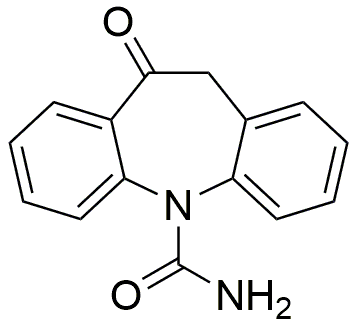Oxcarbazepine is widely utilized in research focused on:
- Epilepsy Treatment: Primarily used as an anticonvulsant medication, it helps manage partial seizures in adults and children, providing an effective alternative to traditional treatments.
- Neuropathic Pain Management: Its analgesic properties make it beneficial for treating nerve pain, offering relief for patients with conditions like diabetic neuropathy or postherpetic neuralgia.
- Psychiatric Disorders: Research indicates potential applications in managing mood disorders, helping to stabilize mood swings in patients with bipolar disorder.
- Drug Interactions Research: It serves as a valuable compound in studies examining interactions with other medications, aiding in the development of safer therapeutic regimens.
- Pharmaceutical Development: Used in the formulation of new drug delivery systems, it enhances the bioavailability of other active ingredients, improving patient outcomes.
Informations générales
Propriétés
Sécurité et réglementation
Applications
Oxcarbazepine is widely utilized in research focused on:
- Epilepsy Treatment: Primarily used as an anticonvulsant medication, it helps manage partial seizures in adults and children, providing an effective alternative to traditional treatments.
- Neuropathic Pain Management: Its analgesic properties make it beneficial for treating nerve pain, offering relief for patients with conditions like diabetic neuropathy or postherpetic neuralgia.
- Psychiatric Disorders: Research indicates potential applications in managing mood disorders, helping to stabilize mood swings in patients with bipolar disorder.
- Drug Interactions Research: It serves as a valuable compound in studies examining interactions with other medications, aiding in the development of safer therapeutic regimens.
- Pharmaceutical Development: Used in the formulation of new drug delivery systems, it enhances the bioavailability of other active ingredients, improving patient outcomes.
Documents
Fiches de données de sécurité (FDS)
La FDS fournit des informations de sécurité complètes sur la manipulation, le stockage et l’élimination du produit.
Spécifications du produit (PS)
Le PS fournit une description complète des propriétés du produit, notamment sa composition chimique, son état physique, sa pureté et les exigences de stockage. Il détaille également les plages de qualité acceptables et les applications prévues du produit.
Certificats d'analyse (COA)
Recherchez des certificats d'analyse (COA) en saisissant le numéro de lot du produit. Les numéros de lot et de lot se trouvent sur l'étiquette d'un produit, après les mots « Lot » ou « Lot de fabrication ».
Numéro de catalogue
Numéro de lot/série
Certificats d'origine (COO)
Ce certificat d'exploitation confirme le pays dans lequel le produit a été fabriqué, et détaille également les matériaux et composants utilisés et s'il est issu de sources naturelles, synthétiques ou autres sources spécifiques. Ce certificat peut être requis pour les douanes, le commerce et la conformité réglementaire.
Numéro de catalogue
Numéro de lot/série
Fiches de données de sécurité (FDS)
La FDS fournit des informations de sécurité complètes sur la manipulation, le stockage et l’élimination du produit.
DownloadSpécifications du produit (PS)
Le PS fournit une description complète des propriétés du produit, notamment sa composition chimique, son état physique, sa pureté et les exigences de stockage. Il détaille également les plages de qualité acceptables et les applications prévues du produit.
DownloadCertificats d'analyse (COA)
Recherchez des certificats d'analyse (COA) en saisissant le numéro de lot du produit. Les numéros de lot et de lot se trouvent sur l'étiquette d'un produit, après les mots « Lot » ou « Lot de fabrication ».
Numéro de catalogue
Numéro de lot/série
Certificats d'origine (COO)
Ce certificat d'exploitation confirme le pays dans lequel le produit a été fabriqué, et détaille également les matériaux et composants utilisés et s'il est issu de sources naturelles, synthétiques ou autres sources spécifiques. Ce certificat peut être requis pour les douanes, le commerce et la conformité réglementaire.


